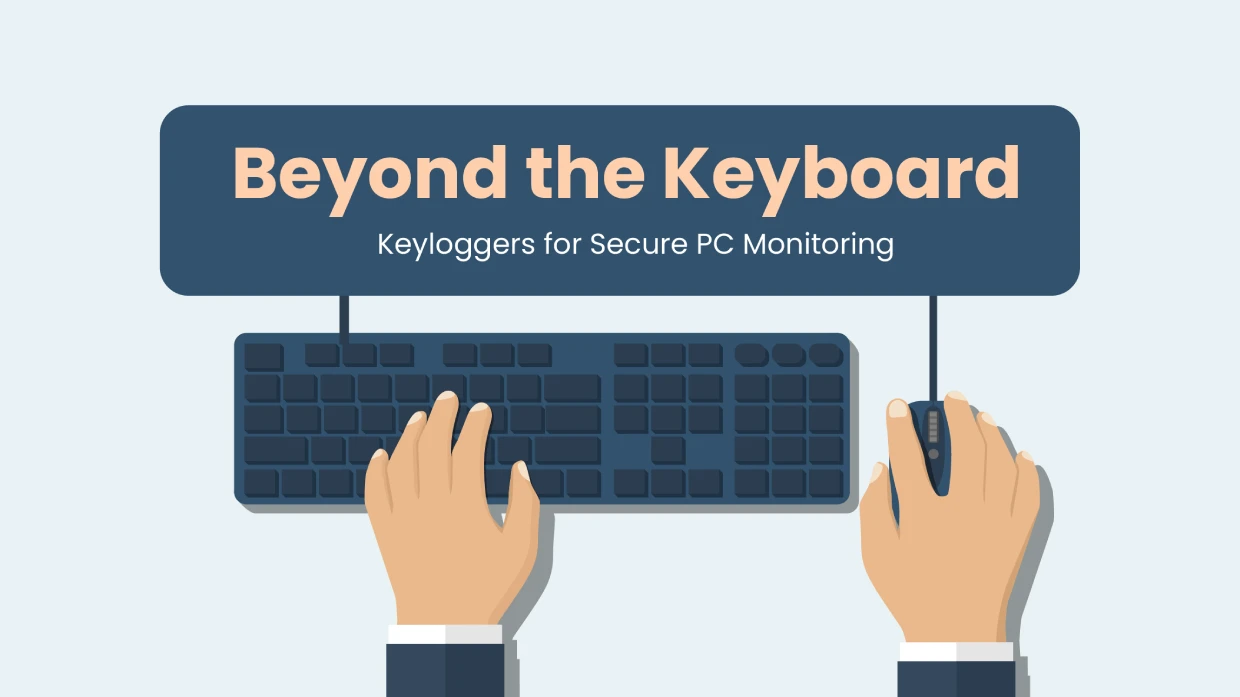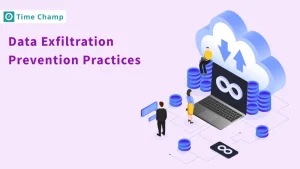Many sophisticated tools in the digital age help in productivity and security. One of these tools is a mysterious technology known as keystroke logging that cyber-security experts also use for their purposes and people who want to track PC activity in secret. In this comprehensive exploration, we delve into the multifaceted world of keystroke loggers otherwise called key loggers, keystroke recorders, or keyboard capture software; their functions, applications, ethical considerations and prospects in cyber security.
Understanding Keyloggers:
Essentially, keystroke loggers are systems or devices that register the keystrokes made on a keyboard. Every time a button is clicked, the keystroke is recorded, capturing every letter, number, or command that a user enters into the system. This stealthy form of surveillance has various implementations: it could also be software working unnoticeably in the background of a PC, a hidden device plugged into the keyboard input port, or part of greater security architecture.
The keystroke software is made to be unnoticeable by a normal user and does not get detected among active processes. This simply implies that the keystroke tracker can collect substantial data ranging from innocent personal conversations to business data to even login passwords, anything typed on the computer.
Types of Keyloggers:
Keystroke logging devices and programs can be categorized into two main types: soft key loggers and hard key loggers.
1. Software-based Keyloggers:
The first type is a keystroke program that is installed on the computer, and it is more common than the second type. Such a key logger software may be an application that can be downloaded, a browser extension, or even a key logger built within a PC system. They act on the background keeping track of all keystrokes without the user noticing. It may also allow users to take screenshots, clipboard content as well as web browsing history.
2. Hardware-based Keyloggers:
Hardware-based key loggers are physical devices (often a non-prominent dongle) inserted into the keyboard’s plug before the computer’s USB or PS/2 ports. Such key-logging devices maintain a trace of every key pressed directly to their onboard storage. They do not require any software installation, making it difficult for antiviruses to detect them since they are platform-independent. Although they are physical, their discovery can involve merely seeing them.
The different varieties of keystroke loggers have their particular uses and strengths as well as shortcomings, which we will consider in further sections. Though software key loggers are adaptable and mighty, hardware key loggers demonstrate the simplicity and subterfuge that their software counterparts might not be able to manage.
We will understand the different forms and operations of these tools to enable us to appreciate their roles in cyber security, personal surveillance, and other technological fields. For now, let’s stop here and go into details concerning specific uses and ethics involved later.
However, those individuals and businesses that would like to experience the functionality of Time Champ should visit Time Champ. Therefore, stay tuned for more on this section that will be revealed in the proceeding chapters.
Keyloggers in Cybersecurity:
There are many things that keyloggers are used for, and one of them is that it is very important to cyber security. As such, keystroke logging software has become an effective tool to trace unauthorized access and conduct forensic analysis into security breaches. As an example, during a sudden event, investigators can determine what the intruder has done by analyzing the trace of the keylogger.
Another advantageous preventative security measure is the usage of keystroke monitoring or keystroke tracking software also known as keylogging programs. The keylogging data can be analyzed by system administrators for indications of a compromised account or malicious activity by an insider. This feature enables fine-grained insights into suspected usage of forbidden commands or odd-hour logins.
Nevertheless, cybersecurity is not always about protection only from outside enemies. It’s also about maintaining a strong internal security posture. Compliance with company policies and data security standards can be ensured by using keylogger PC tools. They work within organizations as a deterrent for unauthorized disclosure of the company’s data or confidential information thereby strengthening organizations from the inside.
Ethical Debates in Keystroke Logging.
However, keystroke loggers are not without controversy. Though keystroke logging is useful in terms of surveillance and security, the issue of privacy becomes a big ethical concern. Every digital stroke will be captured by a keystroke logger for PC of personal conversations, information and many more will not agree for this.
Therein lies the ethical dilemma: striking a balance between the right to privacy and security and oversight. Therefore, a key logger program should be balanced against the privacy invasion factor it introduces and the benefits it offers. In some jurisdictions, it is illegal to capture someone’s keystrokes using keystroke-capturing software without their explicit consent (it falls under the surveillance and wiretapping laws). Legal expertise should be sought by any organization that wishes to implement a keylogger program and its procedures should be transparent while maintaining integrity.
Implementing Keyloggers for Personal and Business Use
The issues that should be taken into account when installing keyloggers include supervising employees’ use of corporate devices and self-monitoring at home PC. The implementation strategies will be determined by the objectives for productivity improvement, protection of confidential data, and user monitoring.
To select key logger software for business use, you must consider your corporate needs. These include features like remote monitoring, triggered alerts, and compatibility with other established security systems. Ensuring that the deployment and user adoption are prioritized will facilitate a seamless transition so that the keystroke-capturing software is fully utilized.
The users would need a keylogger that is discrete and reliable for personal use, as well as easy to administer. It is also important to keep the keylogger program updated and safe from vulnerabilities to avoid divulging private information by chance.
Before getting into the technical underpinnings of this software, businesses must recall productivity and time management aids like Time Champ. Such platforms also have advanced monitoring features that can go hand in hand with keystroke loggers for comprehensive oversight. Time Champ is a platform where interested parties can learn more about the benefits they stand to enjoy.
The Technology Behind Keystroke Logging
Keyloggers are built into the operating systems of a computer through different levels – from the hard disk drive down to the application layer. The most fundamental version of a keylogger may leverage on the interrupt-driven way in which keyboard-in is processed leading to capturing of signals as keys get pressed and released. Some of these more complicated keystroke software may even interact with operating systems’ event handling, tracking input from physical, virtual, and other input devices apart from a simple keyboard.
Keystroke-logging programs are usually implemented in the form of hooking by software (for example). Others might act like kernel drivers that will run with high privileges, thus enabling them to capture keystrokes unnoticeably in the user space. Additional context like what application was in focus when one type can also be captured by the keystroke recorder tools thereby improving their utility for analysis.
Stealthiness is required when designing hardware-based keystroke loggers; they must look legitimate so that they merge with appropriate connectors or devices. The input these key logging devices capture must be stored in onboard memory. There should be ways of transmitting or physically taking out these data.
Choosing the Right Keylogging Software
The choice of keylogger software must go beyond mere functionality. Compatibility with the operating system, ease of operation, stealth capabilities, log management, and advanced functionalities like remote monitoring or automatic reporting should be evaluated by prospective users. A good keystroke tracker for one user could be bad for another based on individual requirements and moral considerations.
It is also prudent to judge the reputation of the software’s developer, taking into account attributes that show reliability such as customer support, regular upgrades, and user comments. Users should note that some key logger software may be malicious or insecure and the users should therefore go for a good brand.
The Risks of Keyloggers and How to Mitigate Them
In addition, alerting users with some proactive measures like employee awareness training can assist users to detect and circumvent these kinds of malicious key loggers. Periodic security checks can detect illegal keystroke logging activity, allowing only legitimate keystroke tracking to be allowed.
Keystroke Logging for Remote Workforce Management.
Keylogging is an innovative approach to monitoring a remote workforce.
However, with the advent of remote work, new issues emerged about supervision and control of the workforce. Keystroke monitoring tools could be used within a broad framework of tools for productivity, safety, and remote work. For example, Time Champ is a combined package that can easily be used in combination with keystroke logging, which provides insight into an employee’s activity pattern as well as time usage.
The use of such monitoring solutions by employers should also consider the privacy regulations and the consent requirements. With keystroke logging and Time Champ, for example, an employer can be assured that remote employees are indeed working as required and in compliance with security standards. It increases the standards that can be implemented for managing and securing the remoteness and hybridity of workspaces.
The Future of Keylogging Software in Cybersecurity
With the progress of keystroke logging technologies comes its cyber security applications. The machine-learning algorithms and behavioural analytics play a crucial role in discovering possible insider threats or unauthorized access instances. Keystroke logging will most probably be incorporated into larger AI-powered security infrastructures that use continuous monitoring of users’ behaviour patterns and risks.
Nevertheless, the framework for ethics and law has to adapt as the technologies also evolve. Privacy concerns and consent will continue to constitute key issues in this discourse, necessitating constant dialogue between technologists, ethicists, legislators, and end users to find a middle ground that is acceptable to all parties involved.
Conclusion:
Understanding keystroke logging devices and software is imperative for anyone looking to enhance personal or business cybersecurity measures. These tools the potential to transform PC monitoring and security but must be handled with care and consideration for privacy and legality.
Technical competence and foresightedness as well as a strong sense of ethics are essential in choosing and installing the most appropriate key logger for a computer-oriented environment. It is important to note that keyloggers are like any other powerful tools, and they have their responsibilities. This is an illustration of how technology, security, and ethics merge to guide the way we live in the modern world wherein they could be used to monitor remote workforce or detect insider threat.
The advancements of the digital world will continuously propel technologies like keystroke logging forward, providing innovative solutions for cybersecurity while at the same time prompting questions about privacy and surveillance balance.
For further information on productivity tools and workforce management that responsibly honour user consent and privacy, book a demo with Time Champ.
Want secure PC monitoring made easy?
Sign up for Time Champ today and experience powerful keylogging insights with complete peace of mind!
Signup for FreeBook DemoFAQs on Keylogging and Keylogger software:
Key logging software operates in the background, remaining undetectable to the user. It captures keystrokes and typically stores the data or sends it to a specified recipient. Advanced key loggers can record additional data such as timestamps and application usage.
Keystroke loggers can be an effective tool for managing a remote workforce, monitoring productivity, and ensuring data security. They should be implemented with care to respect privacy and adhere to legal requirements.







